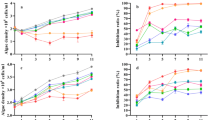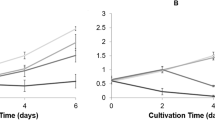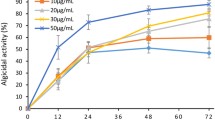Abstract
In recent years, Microcystis bloom occurs frequently and causes a wide range of social, environmental, and economic problems. In this study, dose-dependent inhibitory effect of cinnamaldehyde on the growth of Microcystis aeruginosa was investigated. It was found that cinnamaldehyde with the concentration more than 0.6 mM showed algicide activity against M. aeruginosa. When M. aeruginosa was exposed to 0.6 mM cinnamaldehyde, considerable reactive oxygen species (ROS) were generated followed by lipid peroxidation and decrease in the content of both chlorophyll a and soluble protein. Although superoxide dismutase had made response to the stress caused by cinnamaldehyde, activity increasing after a time of lag could not prevent the lysis of M. aeruginosa cells. Interestingly, the addition of antioxidants glutathione and l-ascorbic acid (Vc) could prevent the lysis of M. aeruginosa cells. All the results suggested that cinnamaldehyde induced the death of M. aeruginosa cells via inducing ROS burst. Further understanding of the mechanism of cinnamaldehyde-induced M. aeruginosa cell death would contribute to the control of cyanobacteria pollution.






Similar content being viewed by others
References
Beauchamp, C., & Frodovich, I. (1971). Superoxide dismutase: improved assays and an assays applicable acrylamide gels. Analytical Biochemistry, 44, 276–287.
Bowles, B. L., & Miller, A. J. (1993). Antibotulinal properties of selected aromatic and aliphatic aldehydes. Journal of Food Protection, 56, 788–794.
Bowles, B. L., Sackitey, S. K., & Williams, A. C. (1995). Inhibitory effects of flavor compounds on Staphylococcus aureus WRRC B124. Journal of Food Safety, 15, 337–347.
Bradford, M. M. (1976). A rapid and sensitive method for the quantification of microgram quantities of protein utilizing the principle of protein-dye binding. Analytical Biochemistry, 72, 248–254.
Briand, J. F., Jacquet, S., Bemard, C., & Humbert, J. F. (2003). Health hazards for terrestrial vertebrates from toxic cyanobacteria in surface water ecosystems. Veterinary Research, 34, 361–377.
Brul, S., & Coote, P. (1999). Preservative agents in foods: mode of action and microbial resistance mechanisms. International Journal of Food Microbiology, 50, 1–17.
Codd, G. A., Bell, S. G., Kaya, K., Ward, C. J., Beattie, K. A., & Metcalf, J. S. (1999). Cyanobacterial toxins, exposure routes and human health. European Journal of Phycology, 34, 405–415.
Engelberg-Kulka, H., Sat, B., Reches, M., Amitai, S., & Hazan, R. (2004). Bacterial programmed cell death systems as targets for antibiotics. Trends in Microbiology, 12, 66–71.
Engelberg-Kulka, H., Amitai, S., Kolodkin-Gal, I., & Hazan, R. (2006). Bacterial Programmed Cell Death and Multicellular Behavior in Bacteria. PLoS Genetics, 2, 1518–1526.
Fallon, R. D., & Brock, T. D. (1979). Lytic organisms and photoxidative effects: influence on blue-green algae (cyanobacteria) in lake Mendota. Applied and Environmental Microbiology, 38, 499–505.
Gill, A. O., & Holley, R. A. (2004). Mechanisms of bactericidal action of cinnamaldehyde against Listeria monocytogenes and of eugenol against L. monocytogenes and Lactobacillus sakei. Applied and Environmental Microbiology, 70, 5750–5755.
Guo, L. (2007). Doing Battle with the Green Monster of Taihu Lake. Science, 317, 1166.
Han, D. C., Lee, M.-Y., Shin, K. D., Jeon, S. B., Kim, J. M., Son, K.-H., et al. (2004). 2’-Benzoyloxycinnamaldehyde Induces Apoptosis in Human Carcinoma via Reactive Oxygen Species. The Journal of Biological Chemistry, 279, 6911–6920.
Health, R. L., & Packer, G. (1968). Photoperoxidation in isolated chloroplasts. I. Kinetics and stoichemtry of fatty acid peroxidation. Archives of Biochemistry and Biophysics, 125, 189–198.
Helander, I. M., Alakomi, H. L., Latva-Kala, K., Mattila-Sandholm, T., Pol, L., Smid, E. J., et al. (1998). Characterization of the action of selected essential oil components on Gram-negative bacteria. Journal of Agricultural and Food Chemistry, 46, 3590–3595.
Humpage, A. R., & Falconer, I. R. (1999). Microcystin-LR and liver tumour promotion: effects on Cytokinesis, Ploidy, and apoptosis in cultured hepatocytes. Environmental Toxicology, 14, 61–75.
Ito, E., Takai, A., Kondo, F., Masui, H., Imanishi, S., & Harada, K. I. (2002). Comparison of protein phosphatase inhibitory activity and apparent toxicity of microcystins and related compounds. Toxicon, 40, 1017–1025.
Jeffrey, S. W., & Humphrey, G. F. (1975). New spectrophotometric equations for determining chlorophyll a, b, c1 and c2 in high plants, algae and natural phytoplankton. Biochemie und Physiologie der Pflanzen, 4, 167–191.
Kohanski, M. A., Dwyer, D. J., Hayate, B., Lawrence, C. A., & Collins, J. J. (2007). A common mechanism of cellular death induced by bacterial antibiotics. Cell, 130, 797–810.
Kolodkin-Gal, I., Sat, B., Keshet, A., & Engelberg-Kulka, H. (2008). Communication factor EDF and the toxin-antitoxin mazEF determine the mode of action of antibiotics. PLoS Biology, 6, 319.
Lam, A. K. Y., Prepas, E. E., Spink, D., & Hrudey, S. E. (1995). Chemical control of hepatotoxic phytoplankton blooms: implications for human health. Water Research, 29, 1845–1854.
Makarova, K. S., Wolf, Y. I., & Koonin, E. V. (2009). Comprehensive comparative-genomic analysis of Type 2 toxin-antitoxin systems and related mobile stress response systems in prokaryotes. Biology Direct, 4, 1–38.
Mazur-Marzec, H., Meriluoto, J., & Plinski, M. (2006). The degradation of the cyanobacterial hepatotoxin nodularin (NOD) by UV radiation. Chemosphere, 65, 1388–1395.
Nagasaki, K., Katanozaka, Y. T., Shirai, Y., Nishida, K., Itakura, S., & Yamaguchi, M. (2004). Isolation and Characterization of a Novel Single-Stranded RNA Virus Infecting the Bloom-Forming Diatom Rhizosolenia setigera. Applied and Environmental Microbiology, 70, 704–711.
Nychas, G.-J. E., & Skandamis, P. N. (2003). Antimicrobials from herbs and spices. In S. Roller (Ed.), Natural Antimicrobials for the Minimal Processing of Foods (pp. 176–200). Cambridge: Woodhead.
Okamoto, O. K., & Colepicolo, P. (1998). Response of superoxide dismutase to pollution metal stress in the marine dinoflagellate Gonyaulax polyedra. Computational Biology and Chemistry, 119C, 67–73.
Paerl, H. W., & Huisman, J. (2008). Climate. Blooms like it hot. Science, 320, 57–58.
Schrader, K. K., Nanayakkara, N. P. D., Tucker, C. S., Rimando, A. M., Ganzera, M., & Schaneberg, B. T. (2003). Novel derivatives of 9, 10-anthraquinone are selective algicides against the musty-odor cyanobacterium Oscillatoria perornata. Applied and Environmental Microbiology, 69, 5319–5327.
Shi, H. X., Qu, J. H., Wang, A. M., & Ge, J. T. (2005). Degradation of microcystins in aqueous solution with in situ electrogenerated active chlorine. Chemosphere, 60, 326–333.
Shiu, C. T., & Lee, T. M. (2005). Ultraviolet-B-induced oxidative stress and responses of the ascorbate-glutathione cycle in a marine macroalga Ulva fasciata. Journal of Experimental Botany, 56, 2851–2865.
Stanier, R., Kunisawa, R., Mandel, M., & Cohen-Bazire, G. (1971). Purification and properties of unicellular blue-green algae (Order Chroococcales). Bacteriology Reviews, 35, 171–205.
Wang, S.-Y., Chen, P.-F., & Chang, S.-T. (2005). Antifungal activities of essential oils and their constituents from indigenous cinnamon (Cinnamomum osmophloeum) leaves against wood decay fungi. Bioresource Technology, 96, 813–818.
Xu, Q. J., Chen, W. M., & Gao, G. (2008). Seasonal variations in microcystin concentrations in Lake Taihu, China. Environmental Monitoring and Assessment, 145, 75–79.
Acknowledgement
This work was supported by the Special Project of National Grand Fundamental Research Pre-973 Program of China under grant no. 2008CB117001.
Author information
Authors and Affiliations
Corresponding author
Additional information
Liang Bin Hu and Wei Zhou contributed equally to this work.
Rights and permissions
About this article
Cite this article
Hu, L.B., Zhou, W., Yang, J.D. et al. Cinnamaldehyde Induces PCD-Like Death of Microcystis aeruginosa via Reactive Oxygen Species. Water Air Soil Pollut 217, 105–113 (2011). https://doi.org/10.1007/s11270-010-0571-1
Received:
Accepted:
Published:
Issue Date:
DOI: https://doi.org/10.1007/s11270-010-0571-1




